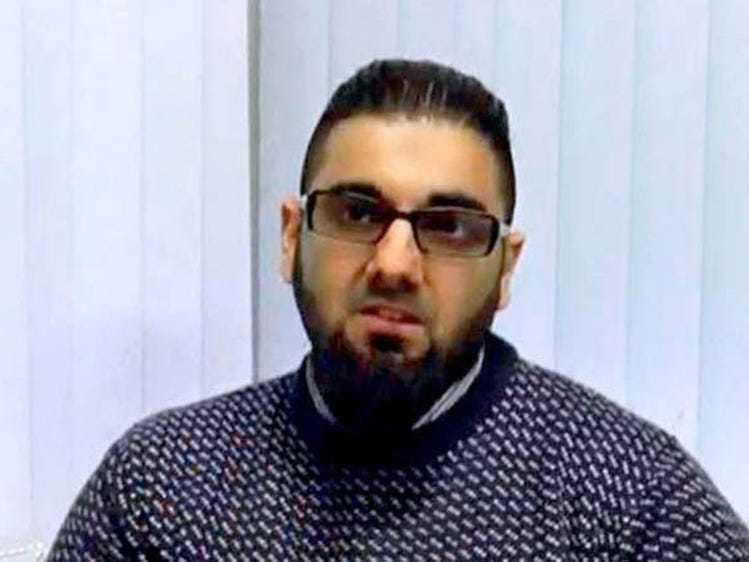Only 12 of the 20 gunshots fired at Fishmongers’ Hall terrorist Usman Khan found their mark, and just three inflicted fatal injuries, an inquest into his death has heard.
Khan was sprayed with bullets by armed officers on London Bridge minutes after he murdered Cambridge graduates Jack Merritt, 25, and Saskia Jones, 23, in the hall on the banks of the River Thames.
Convicted terrorist Khan had been attending a prisoner education alumni event in the grand building on November 2019, just 11 months after being released after an eight-year jail term.
On the day of the attack, he strapped knives to his hands before launching his fatal attack on Ms Jones and Mr Merritt and several other attendees before escaping from the hall on to London Bridge where he was shot dead.
Two shots were fired at 14.02 but Khan continued to move around on the floor until 14.10, at which point a further 18 shots were fired.
He still managed to sit upright briefly before losing consciousness.
The jury was shown computer-generated images of how the bullets had traversed his body, many of them passing through layers of skin, fat and muscle but missing his critical organs.
One shot passed through his nose and gauged a track through his cheek, while another penetrated his shoulder, carved a shallow wound through his chest and abdomen and exited through his left leg.
He was also shot just above his groin, with the bullet passing through his pelvis and exiting just above the level of his right buttock but again missing major blood vessels and organs.
Only three shots, which hit his thoracic aorta, left lung and kidneys, would have caused the catastrophic bleeding that eventually caused him to lose consciousness.
Before armed officers arrived, other attendees at the event tried to incapacitate Khan – striking him with a chair, a fire extinguisher and even a narwhal tusk grabbed from the walls of Fishmongers’ Hall.

“There were a number of gunshot wounds and all of these injuries would bleed to a greater or lesser degree, but those that penetrated the body, and in particular those that damaged the lungs, the kidneys and the thoracic aorta would have given rise to very rapid blood loss.”
He said the bleeding for these key injuries would have occurred predominantly internally.
“Blood pressure would drop and it would drop to a certain degree such that he lost consciousness,” he said.
Dr Fegan-Earl said that as Khan’s critical organs were deprived of oxygen he would have fallen into cardiac arrest.
He said it was not unusual that Khan had survived for so long, nor that he was able to sit upright as the second volley of shots were fired.
“Very, very few injuries in forensic pathology cause instant incapacitation – it is not as we see in film and TV where individuals drop lifeless to the ground and only one gunshot does all of that,” Dr Fegan-Earl said.
“Only a gunshot to a part of the brain vital to the functions of life would do that – we do not have that here.”
He continued: “In the context of a bleeding injury, the heart beats faster to keep blood pressure up, and adrenalin – the hormone released when we feel fear or excitement – will also contribute to that.”

He added that there was no evidence of perimortem injuries – wounds inflicted at the point of death – or post-mortem gunshots.
The jury was told that there was no evidence of drug use by Khan at the time of the attack, and a very low level of alcohol was found in his blood and urine.
“It is certainly the case that natural changes that occur in the body after death may result in the production of alcohol and one has to concede that’s a very possible cause of the presence of alcohol,” Dr Fegan-Earl said.
“Even if it was the alcohol was ingested, Usman Khan would not have been intoxicated.”
Analysis of hair and toenail samples found evidence Khan occasionally used cocaine in the months before his death, and also evidence of heroin use, although this might have been from being around someone who was smoking crack.
As well as the gunshot wounds, Khan had several blunt force trauma injuries consistent with being jabbed with the narwhal tusk, punched and hit with other solid objects.
There was extensive bruising to his hands from being stamped on and crushed with the fire extinguisher by members of the public who tried to disarm him.
He also had lesions from Taser barbs.
The jury is due to retire to consider its conclusion on Thursday.
Jurors will have to decide whether Khan was lawfully killed.






